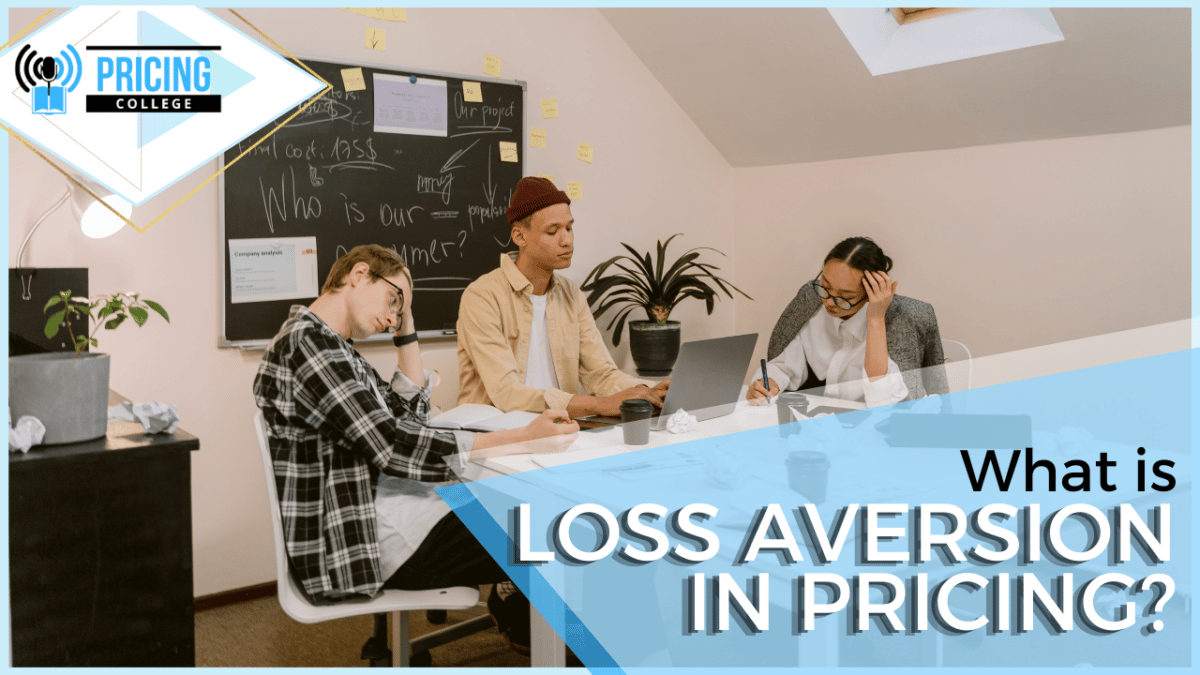
What is Loss Aversion in Pricing? 🏷️ Podcast Ep. 25
In this episode – we look at the concept of loss aversion. It is an old saying in gambling – that money lost hurts twice as much as the pleasure of money won!
This same concept should apply in your sales meetings and sales discussions.
If your product is more reliable and less risky than alternatives – then you should definitely be discussing that – and maybe, charging more for it.
Listen on Apple Podcasts Listen on Spotify Listen on Google Podcasts Listen on Stitcher Listen on Amazon Music
TIME-STAMPED SHOW NOTES
[00:00] Introduction
[01:20] Prospect Theory
[03:01] Customer’s reference point
[04:34] Buyers psychological mindset
Loss Aversion in Pricing – Prospect Theory
Today, we’re going to talk about loss aversion and the role of loss aversion in pricing. Now, loss aversion is an important concept in pricing yet strangely quite underdeveloped. So, we’re just gonna go into the theory in a bit more detail. That theory is called Prospect Theory and then we’ll just provide a few examples.
There’s an old saying in gambling that money lost hurts twice as much as the pleasure of money won. So, when a gambler loses money on the roulette table in Vegas, that hurts them much more than the benefits they might get in winning a similar amount. And that’s something that we can factor in if you’re selling a product.
Think about if your product is more reliable, less likely to break down, and longer-lasting. That’s a real value to the customer that you should make them aware of.
In terms of the theory, it was a guy called Kahneman who developed the Prospect Theory. And like Aidan was saying, what they discovered was that people feel the pain of loss twice as much as any gain or like the pleasure of gain.
I think that’s quite interesting in terms of pricing because often, people set price or develop pricing strategies based on people’s….I suppose feelings of reward. As opposed to the feelings of protecting themselves against loss and risk.
And I suppose one industry in particular that thinks about risk and a little bit more detail is insurance. And how they price, the policies, the life insurance, car insurance. They are always all thinking about risk in a different way than I think other industries can learn from.
Product Reliability
What I like to think of is if you’re selling a product to a buyer and your product is more reliable, it’s a better quality product. In theory, what you’re doing is you’re selling built-in insurance in that product. The chance that they’ll have to pay for repairs or pay for replacement is much lower.
So, if you think about it, you should be able to charge a premium. In theory, that premium would almost be equal to a third-party insurance contract that they can take out.
So, if your product is more reliable, it’s your job as a sales team and a marketing department to make sure that people know that. To make sure that they factor that into their buying decision. And when you’re asking them to put pen on paper, sign on the pricing sheet you want to be asking for a little bit more cash.
An interesting point from the research is that, to what extent do people feel the pain of loss? Everyone does. But the important thing to note is that everyone does feel the pain of loss but very differently.
So, this is when you need to think about loss in terms of different segments. Because there are going to be some people who know that that can almost withhold the pain of loss more.

Gamblers – Loss Aversion
I’m thinking of gamblers. Why do people keep going back and gambling? Yes, they’re almost like gambling through the risk because they think they’re going to recoup their money loss. Or they’re hoping they’re gonna do it.
But they’ve got a higher propensity for loss than say, the gamblers or the tourists that just comes in and plays one or two games. And then is almost too fearful to keep carrying on. Even though probability would say if they just kept on a bit more, they would have won.
So, there are differences and very important differences to note within customer segments in terms of loss. And with all of this as you can see, it’s very customer-focused. Not only are we talking about their behaviour and response to prices.
We’re also talking about their internal feelings to price. Now, in pricing, that’s called the reference point. And everyone’s reference point to different price points is different. And as I said, it shifts. So, it’s a very complicated thing to measure. But, yet a very important one and one that can be trapped if you do it properly.
Psycholigical Mindset of Buyers
I think we’re talking really about the psychology of the buyers. A psychological mindset when making that purchase decision. And sometimes, people don’t think about what can go wrong and they only think about the upside and the benefits of it.
But sometimes, it can be important to have your sales team ready to not be negative but push. Make sure the customer is aware of the potential negatives.
And as I always say, compare apples with apples. We look at the negative sides too, not just the pluses. When you’re making a purchase decision, it’s the pluses and the negatives. And it’s the weighted average of all those things that you’re looking for. Now, that’s something a sales team needs to know about.
Yeah, that’s all I’ve got to add today.
Bottomline
As a pricing manager, I think it’s important to remember that when somebody looks at a price, they can feel both mixed emotions. They can feel the pain of loss. But they also can experience the feeling of pleasure and reward from that price. It’s how you frame your prices which is that marketing aspect.
But thinking about pricing, how do you set prices?
Price is a summation of the value you offer and if we think about value in terms of the reward value in use. But also at that risk element. Then, you can start almost like quantifying different elements of your service offer. Not just the product, the service offer, and how you deliver it to your customers.
By thinking about the pain points, you’re helping them avoid when they buy. And this comes down to observing, understanding your customer base, and trying to hone in on those risk drivers as well as the value drivers.
But yeah, we’ll go into this a little bit more in more detail. It is an interesting, fascinating topic that does require a little bit more thought. And that we’ll do in later series.
For a comprehensive view on building a great pricing team to prevent loss in revenue,
Download a complimentary whitepaper on How to Build Hiring Capability To Get The Best Pricing Team
〉〉〉 Contact Us for a FREE Consultation〉〉〉
Related Posts
Leave a Reply Cancel reply
Categories
- marketing strategy (26)
- Organisational Design (14)
- Podcast (114)
- Pricing Capability (87)
- Pricing Career Advice (10)
- Pricing Recruitment (19)
- Pricing Strategy (287)
- Pricing Team Skills (13)
- Pricing Teams & Culture (24)
- Pricing Transformation (47)
- Revenue Model (25)
- Sales Effectiveness (27)
- Talent Management (7)
- Technical Pricing Skills (35)





